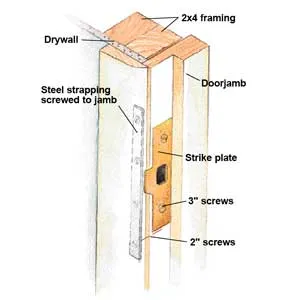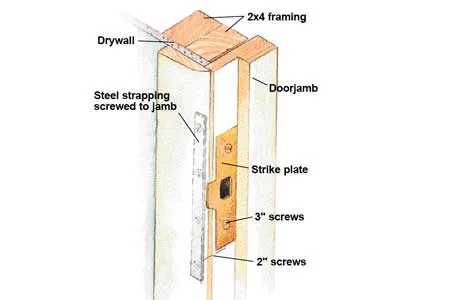
Protecting your home from intruders is a top priority for any homeowner. One of the most effective ways to enhance your home’s security is by installing burglarproof locks. These specialized locks resist forced entry and provide additional protection beyond standard locksets.
In this guide, we’ll explore the various types of burglarproof locks, their key features, and how to choose the right option for your home. We’ll also discuss installation methods, maintenance tips, and complementary security measures to create a robust defense against potential break-ins.
Understanding the Importance of Burglarproof Locks
Standard locksets, while functional, may not provide adequate protection against determined intruders. A well-placed kick or forceful entry attempt can easily compromise a basic lock, leaving your home vulnerable. Investing in high-quality burglarproof locks makes it significantly more difficult for potential burglars to gain unauthorized access to your property.
Types of Burglarproof Locks
Several types of burglarproof locks are available on the market, each offering unique features and benefits. Below, we’ll look at the most common burglarproof locks that can improve your home’s security.
Deadbolts
Deadbolts are one of the most popular and effective types of burglarproof locks. They provide an additional layer of security beyond a standard lockset by extending a solid metal bolt into the door frame. Deadbolts are challenging to pick or force open, making them an excellent deterrent for would-be intruders.
Smart Locks
Smart locks offer a modern approach to home security, combining traditional locking mechanisms with advanced technology. These locks can be controlled remotely via smartphone apps, allowing you to lock or unlock your door from anywhere. Many smart locks also feature keyless entry options, such as keypads or biometric scanners, adding an extra layer of convenience and security.
Keyless Entry Systems
Keyless entry systems eliminate the need for traditional keys, reducing the risk of lost or stolen keys being used to gain unauthorized access. These systems typically use keypads, key fobs, or smartphone apps to grant entry. Some advanced models even incorporate facial recognition or fingerprint scanning technology for enhanced security.
Key Features of High-Quality Burglarproof Locks
When choosing a burglarproof lock, look for the following essential features to ensure maximum security for your home.
Hardened Steel Construction
High-quality burglarproof locks are constructed with hardened steel components, making them resistant to drilling, sawing, and other forced entry attempts. This durable construction significantly increases the lock’s ability to withstand physical attacks.
Extended Bolt Length
An extended bolt length is crucial for effective burglar-proofing. We recommend looking for a hardened steel bolt that extends at least an inch into the doorjamb. This extended reach provides greater resistance against forced entry attempts.
Pick-Resistant Design
Advanced burglarproof locks incorporate pick-resistant designs, such as security pins or sidebars, making them extremely difficult to manipulate using lock-picking tools. While no lock is entirely pick-proof, these features significantly increase the time and skill required to bypass the lock, deterring most burglars.
Choosing the Right Lock for Different Door Types
Different door materials and designs may require specific lock features to ensure optimal protection. Here are some insights on lock compatibility for various types of doors.
Solid Wood Doors
Solid wood doors are sturdy and provide excellent security when paired with high-quality burglarproof locks.
A deadbolt with a hardened steel bolt and reinforced strike plate is an ideal choice. For added security, consider installing both a deadbolt and a lockset on your wood door.
Glass-Paneled Doors
Glass-paneled doors present unique security challenges, as anyone motivated enough can access the lock by breaking the glass.
For that reason, we recommend avoiding locks with a thumb latch on the inside. Instead, opt for a double-cylinder deadbolt that requires a key on both sides.
Doors With Sidelights
Similar to glass-paneled doors, entries with sidelights require special consideration. Double-cylinder deadbolts are recommended for these doors as well. However, it’s essential to balance security with safety concerns.
Deadbolts have a small downside—they make it harder to open the door quickly, making them less ideal in an emergency, such as a fire. If you opt for a deadbolt, you should have a good home safety plan and a practiced exit route.
Professional Installation vs. DIY Installation of Door Locks
Although installing your burglarproof lock yourself may be tempting, professional installation offers the best possible results. Trained locksmiths can ensure proper alignment, reinforcement, and functionality of your new locks. They can also provide valuable advice on additional security measures and may offer warranties on their work.
However, if you’re comfortable with DIY projects and have the necessary tools, installing a burglarproof lock can be a manageable task. Still, we strongly recommend following the manufacturer’s instructions carefully and taking the time to reinforce the door frame properly.
Reinforcing Your Door Frame for Maximum Security
Even the most robust lock is only as secure as its door frame. To maximize your home’s security, consider the following reinforcement techniques.
Installing Steel Strapping
These are small steel straps set behind the deadbolt. They protect the bolt and door frame from kicks or rams. This additional reinforcement significantly increases the door’s resistance to forced entry.
Using Longer Screws
Replace the short screws that come with most strike plates with longer, 3-inch screws. Longer screws will penetrate deeper into the stud and provide a much stronger connection between the lock and the door frame.
Filling Frame Voids
For added strength, fill any voids between the door frame and the wall framing with solid material. This creates a more robust structure that can better withstand force.
Additional Security Measures To Complement Your Locks
While burglarproof locks are a crucial component of home security, they work best as part of a comprehensive security strategy. To further protect your home, we advise implementing the additional measures below.
Security Cameras
Install visible security cameras around your property to deter potential burglars and provide valuable evidence in case of a break-in attempt. Many modern systems allow for remote monitoring via smartphone apps.
Alarm Systems
A home alarm system can alert you and authorities to unauthorized entry attempts. For those interested in a DIY approach, learn how to install your own security system to enhance your home’s protection.
Motion-Sensor Lighting
Install motion-activated lights around your home’s exterior to discourage nighttime intruders and improve visibility around entry points.
Common Mistakes To Avoid When Burglarproofing Your Locks
When securing your home with burglarproof locks, avoid these common pitfalls:
- Choosing low-quality or bargain locks
- Failing to secure all potential entry points
- Ignoring local building codes regarding lock types
- Leaving spare keys in obvious hiding spots
- Neglecting to reinforce the door frame
Maintenance Tips for Long-Lasting Lock Performance
Regular cleaning and lubrication of the lock mechanisms can prevent jamming and other issues. Follow these guidelines to extend the life and function of your lock:
- Tighten any loose screws or hardware to maintain the lock’s integrity.
- Promptly replace any worn or damaged components to ensure your lock continues providing the optimal level of security.
- Test your locks periodically for smooth operation and consider updating or upgrading them as newer, more secure systems become available.
Our Conclusion
By choosing the right type of lock for your doors, properly reinforcing your door frames, and complementing your locks with additional security measures, you can significantly reduce the risk of break-ins and unauthorized entry.
Remember that home security is an ongoing process. Regularly assess your security measures, stay informed about new technologies, and make updates as needed to protect your home against potential threats.

